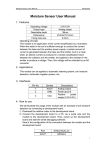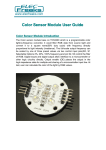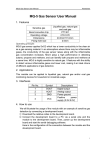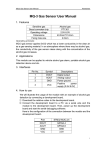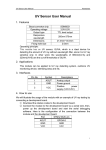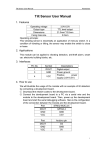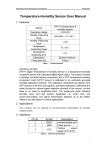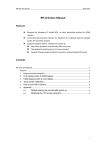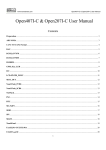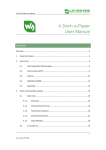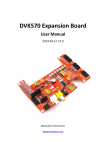Download Color Sensor User Manual
Transcript
Color Sensor User Manual Waveshare Color Sensor User Manual 1. Features Sensing chip Identification type Dimensions Fixing hole size Best detecting distance TCS3200 (full color detector) Static identification 36.0mm*20.5mm 2.0mm 10mm Table 1: Product features Operating principle: The functional block diagram of TCS3200D is shown in the figure below. TCS3200D contains four types of filters: red filter, green filter, blue filter and clear with no filter. When the sensor is illuminated by a ray of light, the types of filters (blue, green, red, or clear) used by the device can be selected by two logic inputs, S2 and S3. Table 2 illustrates the relationship among S2, S3 and filter type. S2 S3 Filter type L L H H L H L H Red Blue Clear (no filter) Green Table 2: Relationship among S2, S3 and filter type TCS3200D outputs a square wave (50% duty cycle) with frequency corresponding to light intensity and color, and the frequency is directly proportional to light intensity. The typical output frequency of TCS3200D is in a range of 2Hz to 500KHz. User can control frequency values of 100%, 20%, and 2% by two programmable outputs, S0 and S1, as Table 3 shown. 1 Color Sensor User Manual Waveshare S0 S1 Output Frequency Scaling L L H H L H L H Power down 2% 20% 100% Table 3: Relationship among S0, S1 and output frequency scaling TCS3200D has different sensitivities to red, green and blue. As a result, the RGB output of pure white is not always 255. Therefore, white balance adjustment is required after power up within 2 seconds. Here are the processes. ① Place a white paper at the top of the sensor in a distance of 1cm, and input a High level voltage to LED port to light up 4 bright white LED indicators. ② The program selects R, G and B filters respectively, and measures the corresponding RGB values of red, green and blue. ③ Calculate 3 adjustment parameters corresponding to red, green and blue respectively, and perform automatic white balance adjustment. 2. Applications This module can be applied to color sorting, environmental light induction and calibration, test strip reading, color matching test, etc. 3. Interfaces Pin No. Symbol Descriptions 1 2 LED OUT 3 S3 4 S2 5 S1 6 S0 7 8 GND VCC Control the states of 4 LED indicators Read the output frequency of RGB Combined with S2, select filters for different color lights Combined with S3, select filters for different color lights Combined with S0, select output frequency scaling Combined with S1, select output frequency scaling Power ground Positive power supply (2.7V-5.5V) Table 4: Interface specifications 2 Color Sensor User Manual Waveshare 4. How to use We will illustrate the usage of the module with an example of color identification by connecting a development board. ① Download relative codes to the development board. The configuration of the connection between the module and the development board are shown in Table 5 and Table 6. Port STM32 MCU pin LED OUT S3 S2 S1 S0 GND VCC 3.3V GPIOA.0 GPIOA.4 GPIOA.3 NC NC GND 3.3V Table 5: Connection between STM32 development board and the module Port Arduino pin LED OUT S3 S2 S1 S0 GND VCC 3.3V D2 D3 D4 D5 D6 GND 5V Table 6: Connection between Arduino and the module The configuration of the serial port is listed in Table 7. Baud rate 115200 Data bits 8 Stop bit 1 Parity bit None Table 7: Serial port configuration ② Place a white paper at the top of the sensor in a distance of 1cm. ③ Power up the development board, and input a High level to LED port to light up 4 bright white LED indicators. 3 Color Sensor User Manual Waveshare ④ Wait for 2 seconds or more after power up (automatic white adjustment is conducted during this period). ⑤ After the adjustment completed, place an objective to be measured at the front side of the sensor. Then, you can see relative data of RGB are outputted. A color check list is helpful for finding out what the measured color it is. 5. Considerations ① Light interference from outside should be avoided, which may affect the result of color identification. It is recommended to place the light source and Color Sensor in a close, light reflection free box for testing. ② White balance adjustment is required whenever Color Sensor module is reset or light source is changed. 4




